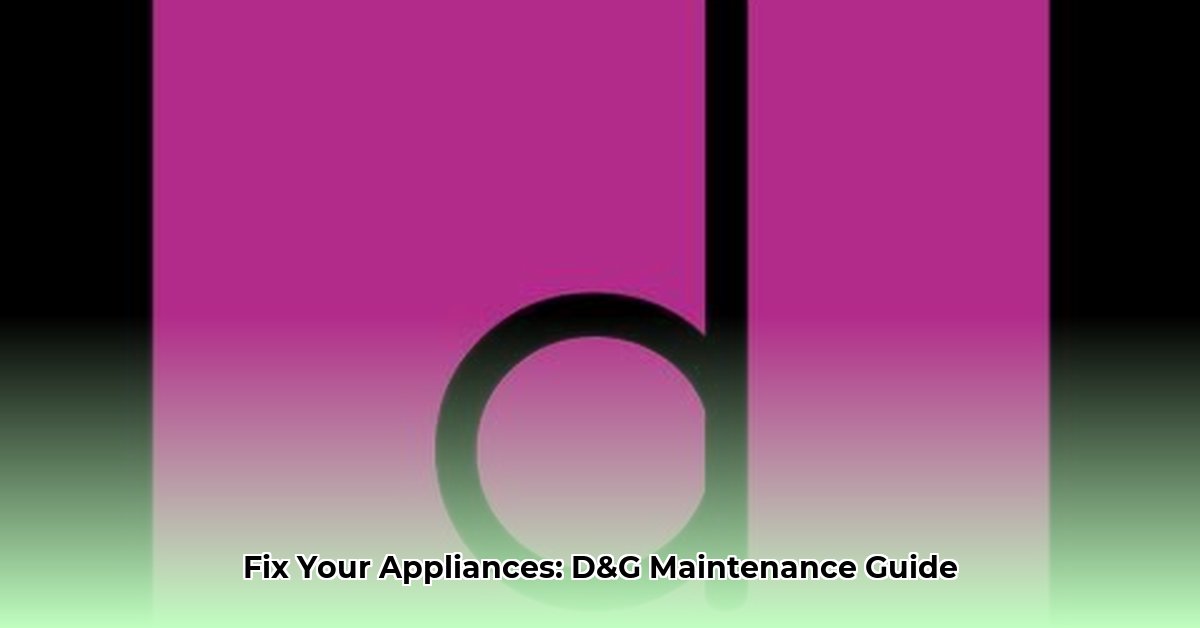
Broken washing machine? Refrigerator on the fritz? Navigating the appliance repair world can be a challenge, whether you're a homeowner or a business owner. This article examines the appliance repair landscape, comparing two contrasting approaches: a large national company (fictionalized as Domestic & General, or D&G) and a smaller, local firm (fictionalized as D&G Maintenance LLC). We'll analyze their strengths and weaknesses, providing actionable advice for both businesses and consumers.
The Appliance Repair Landscape: Giants vs. Local Experts
The appliance repair industry is a diverse field. National giants like D&G leverage economies of scale, offering standardized services and expansive marketing campaigns. They often boast quick response times and readily available service plans. However, maintaining consistent quality across a vast network and individual technician performance remains a persistent challenge. How can a large company ensure consistent service quality across numerous technicians, especially when dealing with the complexity and variety of appliance malfunctions?
D&G: The National Approach
Our fictionalized D&G represents a large-scale player prioritizing efficiency and breadth of service. Their extensive marketing likely reaches a wide audience, and their service offerings encompass a wide range of appliances and brands. However, this model may compromise personalized touch. Standardized procedures ensure consistency, but this may come at the cost of customized solutions for unique appliance problems. Is this standardized approach truly beneficial for customers requiring specialized repairs?
D&G Maintenance: The Local Advantage
D&G Maintenance, our hypothetical local business, contrasts sharply. Their focus is on forging strong community ties and offering personalized service. They might specialize in specific appliance types or brands, establishing themselves as local experts. This approach fosters trust and loyalty. Yet this localized strategy brings its own set of limitations. How do smaller companies compete with the marketing reach and pricing power of larger corporations?
Comparing Service Models: A Head-to-Head Analysis
This table highlights the key differences between our two case studies:
| Feature | D&G | D&G Maintenance |
|---|---|---|
| Scale | National | Local/Regional |
| Service Offering | Standardized packages, broad appliance range | Specialized services, niche focus possible |
| Marketing | Extensive, national reach | Local, focused, often word-of-mouth |
| Customer Base | Large, geographically dispersed | Smaller, geographically concentrated |
| Technician Network | Large, potentially less personalized | Smaller, potentially more personalized |
| Response Time | Generally faster | Potentially slower, depends on workload |
| Pricing | Likely more competitive due to scale | Potentially higher, reflecting personalized service |
| Customer Experience | Standardized, potentially less personal | Highly personal, builds strong relationships |
The choice between these models depends entirely on individual priorities. What factors—speed, cost, personalization—weigh most heavily for you?
Actionable Insights & Strategies for Success:
For large companies (like D&G): Invest in technology for efficient dispatch and technician training. Prioritize customer relationship management (CRM) systems for tracking and managing service requests. Continuous quality control measures are paramount to ensure high standards across your entire network.
For smaller businesses (like D&G Maintenance): Leverage local knowledge and personalized service. Build a robust online presence using platforms like Google My Business. Seek partnerships with local businesses for referrals. Specializing in a niche market can effectively distinguish you from larger competitors. Can effective digital marketing overcome the limitations of a smaller, local operation?
Tips for Consumers: Choosing a Reliable Appliance Repair Service
Choosing an appliance repair service requires careful consideration. Here’s a simple checklist:
- Check Online Reviews: Read multiple reviews across different platforms.
- Verify Credentials: Confirm licensing, insurance, and professional certifications.
- Compare Quotes: Obtain multiple quotes detailing services, warranties, and payment plans.
- Ask Questions: Inquire about technician experience, repair processes, and parts sourcing.
Managing Risk in Appliance Repair: A Mitigation Strategy
Risks exist within the appliance repair industry. Here's a risk assessment matrix showing potential issues and their mitigation strategies:
| Risk Factor | Probability | Impact | Mitigation |
|---|---|---|---|
| Unqualified Technician | High | High | Verify certifications; check reviews thoroughly. |
| Inaccurate Quote | Medium | Medium | Get multiple written quotes; compare details. |
| Part Failure (Post-Repair) | Medium | Medium | Check warranty details carefully. |
| Poor Customer Service | Medium | Low | Read customer reviews; prioritize responsive companies. |
By proactively addressing these risks, you can minimize potential problems and ensure a more positive experience. How can consumers effectively manage the inherent risks associated with appliance repair services?
Conclusion
The appliance repair market is dynamic and competitive. Whether you're a large national corporation or a small local business, adaptability and a strong focus on customer needs are critical for long-term success. Understanding your target audience and providing value-driven service is the ultimate key to thriving in this industry.